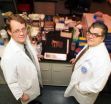Ohio State researchers design a viral vector to treat a genetic form of blindness
2011-11-03
(Press-News.org) COLUMBUS, Ohio – Researchers at Ohio State University Medical Center and Nationwide Children's Hospital have developed a viral vector designed to deliver a gene into the eyes of people born with an inherited, progressive form of blindness that affects mainly males.
The vector is part of a clinical trial investigating the use of gene therapy to cure choroideremia, a disease that affects an estimated 100,000 people worldwide. The trial is being conducted by researchers at the University of Oxford in England.
The vector was designed by Dr. Matthew During, professor of molecular virology, immunology and medical genetics and of neuroscience and neurological surgery at Ohio State, in collaboration with Robert MacLaren, professor of ophthalmology at the University of Oxford, who also leads the trial.
Researcher Dr. K. Reed Clark, director of the Clinical Manufacturing Facility at the Center for Gene Therapy, Nationwide Children's Hospital, and his team produced the clinical-grade vector that is administered to patients in the trial.
During, who is also a visiting professor of translational neuroscience at Oxford, was in the operating room during the pioneering surgery. "I and my colleagues are excited about contributing to this significant medical breakthrough," During says. "We have worked for many years to engineer and optimize viruses to safely deliver genes to humans, and the eye is an ideal target in many ways. The clinical vector manufacturing facility at Nationwide Children's Hospital is outstanding, and Dr. Clark and his team deserve congratulations for providing a clinical vector that for the first time offers these patients the possibility of an effective therapy."
During and his colleagues designed the viral vector to infect the light-sensitive photoreceptor cells that line the back of the eye and make up the retina. Choroideremia causes a degeneration of these photosensitive retinal cells and progressive blindness. The diagnosis is usually made in childhood and leads to blindness by around age 45
"This trial represents the first attempt to treat this disease and the first time that gene therapy has been directed towards the photoreceptor cells of the human retina," During says. "We believe it holds great promise for the treatment of other genetic causes of blindness such as retinitis pigmentosa."
The trial's 12 patients will be treated in one eye. It will take 24 months to know whether the gene-therapy treatment has stopped the degeneration. The trial builds on gene-therapy research performed in collaboration with Professor Miguel Seabra at Imperial College London, along with During and Clark at Ohio State.
"This disease has been recognized as an incurable form of blindness for over a hundred years," MacLaren says. "I cannot describe the excitement in thinking that we have designed a genetic treatment that could potentially stop it in its tracks with one single injection."
###
END
ELSE PRESS RELEASES FROM THIS DATE:
2011-11-03
Although initially linked with tropical climes as a way to shield against heat and strong sunshine (the chance would be a fine thing in this country!), shutters are also a perfect window treatment to help keep us warm and cosy during cold, wintry weather (that'll be a fair proportion of the year then!).
As they fit snugly and tightly into the window recess, effectively 'closing' off the window, they provide better insulation than curtains or blinds. Making the most of natural daylight is even more important during the shorter winter days and shutters allow you to let ...
2011-11-03
New York, November 2, 2011 -- A woman goes into labor, and gives birth. The newborn is swaddled and placed to sleep in a nearby bassinet, or taken to the hospital nursery so that the mother can rest. Despite this common practice, new research published in Biological Psychiatry provides new evidence that separating infants from their mothers is stressful to the baby.
It is standard practice in a hospital setting, particularly among Western cultures, to separate mothers and their newborns. Separation is also common for babies under medical distress or premature babies, who ...
2011-11-03
PROVIDENCE, R.I. – A newly published paper from Rhode Island Hospital reports that Web-based assessments for outcome measurements of patients in treatment for depression are valid and reliable. The findings indicate that the Internet version of the depression scale was equivalent to the paper version, and that patients preferred the Internet version. The paper is published in this month's edition of the Journal of Clinical Psychiatry.
Lead author Mark Zimmerman, M.D., director of outpatient psychiatry at Rhode Island Hospital, and his colleagues studied 53 psychiatric ...
2011-11-03
WASHINGTON — A new data network that integrates emerging research on the molecular makeup of diseases with clinical data on individual patients could drive the development of a more accurate classification of disease and ultimately enhance diagnosis and treatment, says a new report from the National Research Council. The "new taxonomy" that emerges would define diseases by their underlying molecular causes and other factors in addition to their traditional physical signs and symptoms. The report adds that the new data network could also improve biomedical research by ...
2011-11-03
AUGUSTA, Ga. – Examining the chin and upper and lower abdomen is a reliable, minimally invasive way to screen for excessive hair growth in women, a key indicator of too much male hormone, researchers report.
"We wanted to find a way to identify this problem in women that was as non-intrusive and accurate as possible," said Dr. Ricardo Azziz, reproductive endocrinologist and President of Georgia Health Sciences University.
"We believe this approach is approximately 80 percent accurate and will be less traumatic for women in many situations than the full body assessments ...
2011-11-03
At present, with the amount of domestic meteorite collectors increasing rapidly, meteorite collection is becoming more and more popular. The website http://www.meteorite.hk was born as an answer to these times.
The Hong Kong meteorite website was founded by the Hong Kong Best Tone Group Limited; it is not just a professional platform to show meteorites, but also a transaction platform for the meteorite collectors from all over the world and it will provide an international campaign.
The Hong Kong meteorite website was identified by the major meteorite authority; it ...
2011-11-03
WASHINGTON, Nov. 2, 2011 — Just as people who have the enthusiasm and energy to make things happen are called catalysts, their namesakes — chemical catalysts — also are facilitators, jump-starting chemical reactions that would never work or would work too slowly. Almost everything we rely upon in everyday life — 90 percent of all commercially produced products (a trillion dollars worth each year) — involve catalysts at some stage of their manufacture.
A new episode in the 2011 edition of a popular video series from the American Chemical Society (ACS), the world's largest ...
2011-11-03
Converting sunlight into electricity is not economically attractive because of the high cost of solar cells, but a recent, purely optical approach to improving luminescent solar concentrators (LSCs) may ease the problem, according to researchers at Argonne National Laboratories and Penn State.
Using concentrated sunlight reduces the cost of solar power by requiring fewer solar cells to generate a given amount of electricity. LSCs concentrate light by absorbing and re-emiting it at lower frequency within the confines of a transparent slab of material. They can not only ...
2011-11-03
Pediatric researchers who tested newborn animals with an existing human drug used in adults with diabetes report that this drug, when given very early in life, prevents diabetes from developing in adult animals. If this finding can be repeated in humans, it may become a way to prevent at-risk infants from developing type 2 diabetes.
"We uncovered a novel mechanism to prevent the later development of diabetes in this animal study," said senior author Rebecca A. Simmons, M.D., a neonatologist at The Children's Hospital of Philadelphia. "This may indicate that there is an ...
2011-11-03
Antibodies Trick Bacteria into Killing Each Other
The dominant theory about antibodies is that they directly target and kill disease-causing organisms. In a surprising twist, researchers from the Albert Einstein College of Medicine have discovered that certain antibodies to Streptococcus pneumoniae actually trick the bacteria into killing each other.
Pneumococcal vaccines currently in use today target the pneumococcal capsular polysaccharide (PPS), a sort of armor that surrounds the bacterial cell, protecting it from destruction. Current thought hold that PPS-binding ...
LAST 30 PRESS RELEASES:
[Press-News.org] Ohio State researchers design a viral vector to treat a genetic form of blindness




